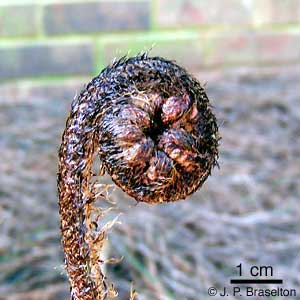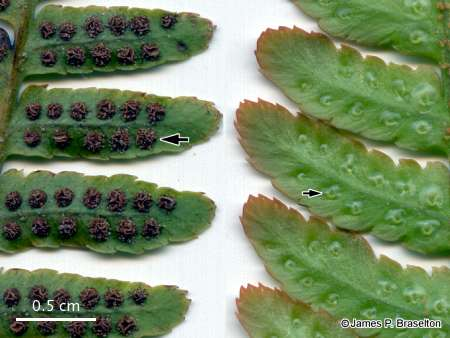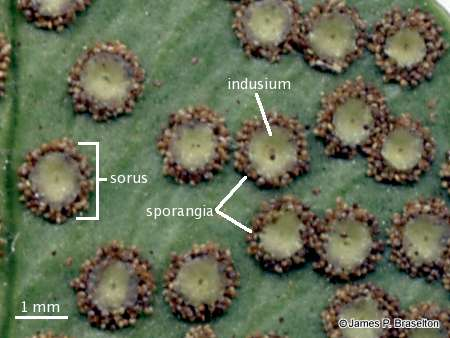
Pteridophytes are a large group of plants that have vascular tissue but do not produce seeds. The most common pteridophytes are the ferns, so we use ferns in this set of readings as our only example of a pteridophyte—the non-seed vascular plants.
Ferns are beautiful plants recognized mostly by their graceful leaves. The leaves botanically are referred to as fronds. The veins of the fronds are vascular bundles, hence ferns are classified in the vascular plants. The fronds are part of the sporophyte, each cell, therefore, is diploid (2n).
Many ferns spread by horizontal underground stems, the rhizomes. At the nodes of rhizomes fronds grow up; roots grow down from the nodes. Young fronds are shaped like a shepherd's crook or crosier, and, therefore, are called crosiers. Another term often applied to crosiers is fiddlehead.

Sporophytes produce spores through the process of meiosis within sporangia. The little dots on the underside of fern fronds are collections of sporangia—the collections are known as sori (sorus is the singular). Sori may be circular, oblong, or linear, depending on the species of fern.

Sori on the undersides of leaflets of fern leaves (fronds). Mature sori on the left (large arrow); very young sori on the right (small arrow).
The shapes of the sori are characteristics used by many botanists to classify ferns. In some ferns, each sorus has a little cap known as the indusium.

Higher magnification of sori on the underside of leaflet of fern leaf (frond). This species of fern has indusia. Sporangia can be seen sticking out from under the indusium of each sorus
Meiosis occurs in each sporangium within the sorus, producing haploid (n) spores. Only one type of spore is produced in fern sporangia. Ferns, like mosses, are homosporous. Each sporangium has a group of specialized cells, the annulus, that straighten out at maturity and rip apart the sporangium. When this occurs spores are released into the air.
Each spore that lands on a suitable, moist site germinates. First a filamentous structure, the protonema, is formed. The protonema is the immature gametophyte. As the protonema develops into the mature gametophyte (prothallus), it becomes heart-shaped. Note that the fern gametophyte is green (i.e., photosynthetic) and free-living from the sporophyte. It is also much smaller than the sporophyte. A typical fern gametophyte is about the size of a fingernail. Each cell of the gametophyte is haploid (n).
On the underside of a mature fern gametophyte are the sperm-producing antheridia and egg-producing archegonia. Sperm swim from the antheridia to the archegonia. One sperm swims up the neck of an archegonium and fuses with the egg to form the diploid zygote, the first cell in the sporophytic generation.
The zygote divides, and after a series of cell divisions the young sporophyte can be seen growing from the gametophyte. The young fern sporophyte is not dependent on the gametophyte. Instead, the fern sporophyte gets larger than the gametophyte, eventually obscuring or crushing it. The sporophyte grows at the apical meristem of the stem.